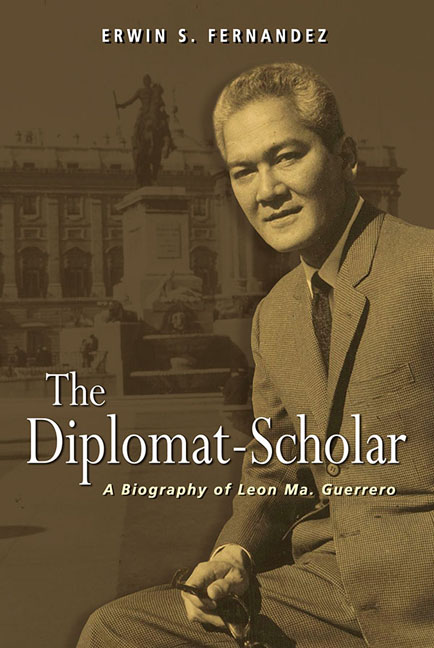Book contents
- Frontmatter
- Dedication
- Contents
- Preface
- Prologue
- Chronology
- I Ermita and Santa Cruz to Intramuros: Between Literary and Legal Career
- II To Tokyo and Back: The Making of a Diplomat
- III Going In, then Out of the Political Jungle: Padre Burgos to Arlegui
- IV London and Madrid: The Philippines in a Resurgent Asia
- V New Delhi to Belgrade: The Philippines towards Non-Alignment
- 18 Homecoming to Asia at Nehruvian India
- 19 “Diplomacy of Development” and Other Speeches
- 20 The Foreign Policy Rescuer and Again, Critic
- 21 The Diplomat as Efficient Intellectual-Bureaucrat
- 22 Endorsing Non-alignment amid Personal Crisis
- 23 Flirting with Dictators
- 24 Martial Law Propagandist
- 25 At Tito's Pre-Balkanized Yugoslavia
- Epilogue
- Glossary
- List of Abbreviations
- Bibliography
- Index
- About the Author
18 - Homecoming to Asia at Nehruvian India
from V - New Delhi to Belgrade: The Philippines towards Non-Alignment
Published online by Cambridge University Press: 12 January 2018
- Frontmatter
- Dedication
- Contents
- Preface
- Prologue
- Chronology
- I Ermita and Santa Cruz to Intramuros: Between Literary and Legal Career
- II To Tokyo and Back: The Making of a Diplomat
- III Going In, then Out of the Political Jungle: Padre Burgos to Arlegui
- IV London and Madrid: The Philippines in a Resurgent Asia
- V New Delhi to Belgrade: The Philippines towards Non-Alignment
- 18 Homecoming to Asia at Nehruvian India
- 19 “Diplomacy of Development” and Other Speeches
- 20 The Foreign Policy Rescuer and Again, Critic
- 21 The Diplomat as Efficient Intellectual-Bureaucrat
- 22 Endorsing Non-alignment amid Personal Crisis
- 23 Flirting with Dictators
- 24 Martial Law Propagandist
- 25 At Tito's Pre-Balkanized Yugoslavia
- Epilogue
- Glossary
- List of Abbreviations
- Bibliography
- Index
- About the Author
Summary
From the Iberian Peninsula, Guerrero crossed to India, a homecoming to Asia after more than ten years of exile in the heartland of Europe. Great Britain and Spain combined, almost a quarter of India's total land area, was no match to a subcontinent. India was the cradle of human civilization older and more ancient than the West. He had been to London, the metropolis that during the heydays of empire ruled colonial India until its independence in 1947. Writing about Philippine-India relations in 1952, Guerrero noted how the two countries diverged, never to converge, in their way of looking at world affairs. India maintained diplomatic relations with the United States and the USSR, choosing not to side with either camp; it recognized Communist China instead of Taiwan and backed its entry to the UN — the exact opposite of Philippine policy — but with an anti-communist posture on the domestic front, the only similarity between Indian and Philippine foreign policies. In 1966 the template in those relations changed from an attitude of suspicion during the height of the Cold War to a meeting of minds with the upgrading of legations to embassies, increase in technical cooperation, intensified cultural and student exchanges, and state visits — the favourable situation Guerrero would find himself in June.
Guerrero and Annie stayed at the embassy residence located in Friends Colony (West) with the chancery situated at B66, Greater Kailash I. Unlike the London and Madrid embassies, the New Delhi embassy moved from one place to another. Under Ambassador Narciso Ramos, now the Foreign Affairs Secretary, it had offices at Suites 32-37 Indra Palace Building, Central Ring, Connaught Place. Then, during the terms of Ambassadors Manuel A. Alzate and Mauro Calingo, it moved to the third floor of the Thapar, Thipar or Thaper (different spellings in the directories) Building, 124 Jan Path. The mission had jurisdiction on a non-residential basis over the Kingdom of Nepal and oversaw honorary consulates in Calcutta, Bombay and Madras, the only three in the whole of India.
- Type
- Chapter
- Information
- The Diplomat-ScholarA Biography of Leon Ma. Guerrero, pp. 223 - 232Publisher: ISEAS–Yusof Ishak InstitutePrint publication year: 2017



